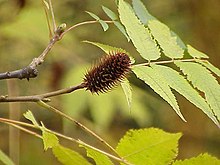Platycaryeae
| Platycarya | |
|---|---|
 |
|
| Autumn foliage and fruit | |
| Scientific classification | |
| Kingdom: | Plantae |
| (unranked): | Angiosperms |
| (unranked): | Eudicots |
| (unranked): | Rosids |
| Order: | Fagales |
| Family: | Juglandaceae |
| Tribe: | Platycaryeae |
| Genus: |
Platycarya Siebold & Zucc. |
| Species: | P. strobilacea |
| Binomial name | |
|
Platycarya strobilacea Siebold & Zucc. |
|
Platycarya is a genus of flowering plants in the family Juglandaceae, usually treated as comprising a single species Platycarya strobilacea, though one to two additional species are accepted by some authors. It is native to eastern Asia in China, Korea, and Japan.
It is a deciduous tree growing to 15 m tall. The leaves are usually pinnate, 15–30 cm long with 7–15 leaflets (rarely simple, or with up to 23 leaflets), the terminal leaflet present; the leaflets are 3–11 cm long and 1.5–3.5 cm broad. The flowers are catkins; the male (pollen) catkins are 2–15 cm long, the female catkins 2.5–5 cm long at maturity, hard and woody, superficially resembling a conifer cone with spirally arranged scales.
Galloyl pedunculagin can be found in P. strobilacea.
...
Wikipedia
